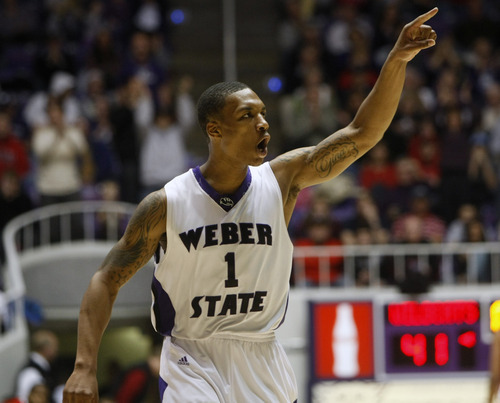This is an archived article that was published on sltrib.com in 2012, and information in the article may be outdated. It is provided only for personal research purposes and may not be reprinted.
There can be no blaming junior guard Damian Lillard for Weber State's loss to Montana in the finals of the Big Sky Conference tournament, considering his statistical line: 29 points, 10 rebounds, seven assists.
Yet he could have a mixed legacy in Ogden, remembered partly for never having appeared in the NCAA Tournament. Lillard is likely to enter the NBA Draft, as a player projected to be taken in the middle of the first round.
His three Wildcat teams — not counting last season, when he broke his foot in the ninth game — have lost twice at home and once on the road in the conference tournament. The league's two-time MVP performed much better Wednesday than in previous tourney defeats, but the bottom line is the country's No. 2 scorer could not get Weber State (24-6) into the NCAAs.
The Wildcats lost at Montana to conclude the regular season last week as Lillard and his teammates shot poorly, then they crumbled Wednesday in an 85-66 defeat after leading by five points at halftime.
Lillard deserves credit for his comeback from the injury and the improvement of his all-around game this season. He's ready for the NBA. Yet his departure would be disappointing, because coach Randy Rahe made an extra effort to get back Lillard's year of eligibility. Rahe added a previously unscheduled game at Saint Mary's, just so the math would work out to where Lillard had played in only 30 percent of WSU's games and was eligible for a redshirt season.
He's been everything you could ask for in a college basketball player: a team leader, dedicated worker and good student. If his career ends this month after the NIT or another auxiliary event, though, Lillard would be known as by far the best Wildcat player never to compete in the NCAA Tournament — and possibly the best player from any Utah school in Division I basketball. Here's the player who fits that description from each school in the last 50 years, since the NIT lost significance:
Mike Newlin, Utah • Still the Utes' No. 5 all-time scorer after playing three varsity seasons, the guard posted a 23.1 career scoring average from 1968-71 and went on to play 11 seasons in the NBA.
Shaler Halimon, Utah State • As a junior college transfer, Halimon averaged 23.5 and 26.8 points in two seasons for the Aggies in 1966-68 and was a first-round pick of the Philadelphia 76ers. His pro career was undistinguished, however, as he played in only 254 games in the NBA and ABA.
Jay Cheesman, BYU • The center from Orem is the Cougars' No. 14 all-time scorer, with a 13.7 average from 1973-77.
Ryan Toolson, Utah Valley • The nephew of Danny Ainge once scored 63 points in a four-overtime game and finished with 2,163 points, averaging 23.8 points as a senior in 2008-09.
Davor Marcelic, Southern Utah • Arriving just after the school moved into Division I in 1988, the forward from Croatia scored 1,710 points in his career.
Lillard should not be on this list, simply because the NCAA Tournament has grown to 68 teams and Weber State is an established program with automatic access via the Big Sky. But getting there requires coming through at just the right time, and Lillard and his teammates could not do it.
He'd still look good in a Jazz uniform. John Stockton never got Gonzaga into the NCAAs, and his NBA career turned out fairly well.
Twitter: @tribkurt



